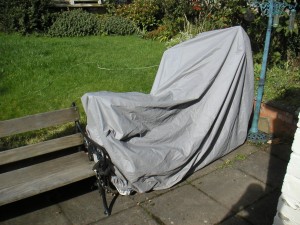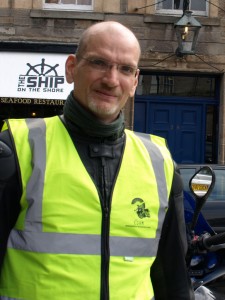I don’t normally take Bluhofi to work, as I live only 10 minutes walk from the office. But today I had a dentists appointment before work, and then my first IAM Observed Ride in the evening.
So after work I headed to Ocean Terminal, grabbed a sandwich and ate it quickly, then headed out to meet Alan, my Observer, at the McDonald’s car park in South Queensferry.
It had been a wet day, but the rain was mostly gone by the time I got there – wet roads, but no need for waterproofs. I’d no idea what to expect from the ride, but was nervously looking forward to it.
Alan was easy to find, white helmet and yellow hi-viz jacket, parked at the back of the car park. I pulled up next to him, and parked my bike, aware he’d been watching me ride into the car park, pull up and park up the bike. Alan put me at my ease pretty quickly – I guess I’d expected someone who was a bit of a Highway Code anorak, but he came across as a solidly competent rider.
We started with a briefing on how the rides work. I’m responsible for my own safety, regardless of what he does, or asks me to do, I need to make sure I’m comfortable that I’m safe. He’d be riding behind me, possibly to the right or left so he can see what I’m doing, and possibly much closer than normal. I was just to ignore him, and ride as if he wasn’t there – except that he’d use his indicators to show me when to turn. I was to show I was making good progress, but not break any speed limits – so where safe, ride at 30 in a 30 limit, 40 in a 40 limit, and so on – but not accelerate until past the end of limit signs.
He then talked about how I’d ridden into the carpark and parked. I’d pulled up by the space, and then, with the engine still running, waddled the bike backwards into the space. I think I’ve always parked like that since I got a heavier bike – but as Alan pointed out, it’s not safe – I could slip and drop the bike, it could kick into gear. Instead, I should stop, put the side stand down, turn off the engine, and push the bike back into the space. It’s probably going to mean I need to change how I park the bike at home too – cars often leave me only minimal space to get the bike back out.
Then we went for a ride – along the A904 through the varying 30, 40 and 50 limits. There was a sportsbike behind us through the limits, and it zoomed past us just as we were passing the national limit sign – a good illustration of why you should do a shoulder check as you reach the end of a speed limit. We turned under the motorway on the B8046, and headed to Newbridge, stopping a couple of times for a chat about how I was doing.
At Newbridge, we did some slow speed manoeuvres in a carpark – Alan asked me to demonstrate circles and figure of eights under good control. Its been a good while since I’ve done those, and I think a bit of practice would improve my skills, but I did OK.
We ended up back where we started at McDonalds for a chat over the ride, and an assessment of where I was. Alan said I was doing really well for a first ride – safe, legal, and showing that I had an understanding of the IAM system of riding.
Learning points from today:
- Starting and stopping drills, off the bike with side-stand down when parking, covering the back brake when stopping and moving off.
- I use the front brake too much at low speed (perhaps those spills in the past were avoidable!), I should use the back brake at low speeds for stability.
- Road positioning – need to be more precise, using the “middle of the lane” safety position in 30, 40 and most 50 limits, and when there’s oncoming traffic. I’ve got a habit that leads back to my original bike training of never riding in the middle of the lane that I need to break out of.
- BETOPS – the Edinburgh group’s system for doing basic mechanical safety checks on a bike – need to learn this.
- My observations in town are good, but need to be much more definite out of town.
Next ride is on Sunday, so not much time to practice in between. I’ll get out for at least one ride though.






